Between 1982 and 1989, Touch released a series of cassettes [as well as vinyl, and from 1987, compact discs] which are highlighted in this section. The cassette magazines, Feature Mist [Touch T1, 1982], Meridians One and Meridians Two [Touch T2 and T3, 1983], Touch Travel [Touch T4, 1984] and Ritual: Magnetic North [Touch T5, 1986]; a series in the style of what became known as “World Music” [Touch # T33 to T33.9]; and the beginnings of solo or group ventures [TO:1, TO:2, TO:4 and TO:7, and TOC:1 and TOC:2]. They were packaged either as a standard cassette with extended inlay card, or with an A6 booklet in a clear plastic wallet. Here for the historical record are the front cover artwork, the audio (including some listening files) & visual content, and notes. All are out of print, of course. The contents and credits are copied directly from the productions themselves.
The front covers and details of other print, audio content and liner notes are presented as they appeared on the original productions. In future we will be rolling out pages detailing printed matter, posters, vinyl and other items which were released in the 1980s.
Fergus Kelly has written a blog about his experiences relating to this early period which can be read here. He has also reproduced many of the prints which appeared in these early editions.
Audio has been added over time to some of the titles, with kind permission of the artists.
1982

Feature Mist [T1]
Side One
Vladimir Mayakovsky: Final Verse, “Last Poem”
New Order: Video 586 – 1
Soliman Gamil – The New Nubia
Robert Wyatt, from an interview
The Death & Beauty Foundation: Song of the Houseproud Ghost
Hans Eisler/Mayakovsky: Subbotnik
Eric Random Meets the Bedlamites In Cassette Conference
Side Two
Simple Minds: King Is White
Tuxedomoon: Shelved Dreams
Shostakovitch: Waltz from ‘The Bedbug’
New Order: Video 586 -2
Flesh : Hesitate
Audio notes:
“Last Poem” read by Ian McCurragh. “Video 5-8-6” written and produced by New Order, initially as soundtrack to the opening of The Hacienda in Manchester, England. “The New Nubia” courtesy of The Egyptian Cultural Embassy. The Death And Beauty Foundation by Val Denham and A.M.McKenzie. Hans Eisler and Vladimir Mayakovsky recording courtesy of The Museum of Modern Art, Oxford. The Bedlamites on this occasion were Wayne, Dids and Lyn Seed. Simple Minds produced and engineered by Peter Walsh; licensed by Virgin Records Ltd. Tuxedomoon-Peter Principle, Steven Brown, Blaine L. Reininger-mixed and engineered by Gilles Martin; text by Blaine L. Reininger. Shostakovitch arranged by Gerard McBurney; performed by Kathron Sturrock (piano), Horoutune Bedilian (violin), Elizabeth Wilson (cello), and recorded live at the Riverside Studios. “Hesitate” composed and recorded by George Handleigh and A.M.McKenzie.
Visual content:
A5 32pp booklet featured the work of Keith Breeden, Neville Brody, Panny Charrington, Malcolm Garrett, Hipgnosis and Ian Wright, with manifestos by The Death And Beauty Foundation and The Temple Ov Psychick Youth (written by David Tibet). Also published were The Rozztox Manifesto (by Gary Panter / The Residents), “Vladimir Mayakovsky” by Alan Reid, Norrie MacLaren’s “Video Column”, “The New Nubia”, and Your Guide To Naming A Pop Group, “Nominal Success” by Shirley Ellis. Cover photography by Panny Charrington.
Feature Mist was produced by A.M.McKenzie, Garry Mouat and Jon Wozencroft with the assistance of Michael Harding. A cassette-only edition was remastered in March 1986.
1983

Meridians One [T2]
Side One
Matador! – Nowever, Ornever
AC Marias – The Whispered Year
sigil one
Pascal Gabriel – Machu-Picchu
mother earth film music
Touch 33º – Oral Tradition
Graham Lewis – He Said “Argh…”
John Foxx – The Quiet Man 4
Simon Fisher Turner – Wash
Side Two
sigil two
Current 93 – Salt
Touch 33º – The Crucible
Test Department – Efficiency
S/Z – Text
The Pathfinders – Long Shadows
NOTi – Diagnosis
sigil three
Ludus – Corpse Candle
Produced by Harding/McKenzie/Mouat/Wozencroft

Meridians Two [T3]
Side Three
Wendy Chambers – Star Spangled Banner
400 Blows – 399 To Go
A Certain Ratio – Si-Fermir-Ogrido
masse;rebel (behind the front line)
Deux Filles – Airium
The Nocturnal Emissions – Body Count
Jean Tinguely – Meta-Harmonie 11
Derek Jarman – The Archaeology of Sound
Matador! – Mother Earth Film Music
Side Four
John Foxx – The Quiet Man 3
Bruce Gilbert – Children
Virginia Astley – When the Fields were on Fire
Gorp – Give Me the Moonlight
Pure – Disconnected
Touch 33º – ai
Mulligan & Smith – Walk on By
Audio notes:
400 Blows are Andrew E. Beer & Alexander S. Fraser. Courtesy of Concrete Productions. Deux Filles are Gemini Forque & Claudine Coule. Saxophone on ai – Geoff Blyth. Walk on By – Bacharach & David, arranged by Mulligan & N. Smith – courtesy of De Stijl.
Visual content:
Contributions by Panny Charrington, Neville Brody & Chris Moretone, Graham Elliot, Russell Mills, John Foxx, Peter Saville, Tom Aldam, Wolfram Jacob, Caroline K, Mooie Charrington, Linder, Brett Wickens, Steven Appleby, Jon Barraclough and Malcolm Garrett & Roger Cleghorn.
“Touch can be anything it desires, from words to music to images. Each medium received equal opportunity and the only necessary pre-item is conviction with tolerance. No two items are alike. Sameness is anathema. Quality is only born of change and that stimulus is the real motivation.”
P.V.C. wallets by P.R. Hunter (Plastics) Ltd. Screen printing by Art-O-Matic. Typeset in Clarendon, Optima & Palatino by Focus Photoset Ltd. Full colour printing by Miter Press Ltd. Cover printing by Owlhouse Partnership.
Produced by Harding/McKenzie/Mouat/Wozencroft
1984

Touch Travel [T4]
Side One
Eithne Ni Bhraonain – An Ghaoth O’n Ghrian (The Solar Wind)
Scene Two
General Strike – My Other Body
Clockface
Brian Gulland & Frank Ricotti – Journey
Swastika Bells
1000 Mexicans – Trans-Astrakhan (Seeing The World)
Body Talk
Old Silk Route – Pig Slaughter
3 Mustaphas 3 – Bam/Tsifteteli
Quimantu – Interview
Yanomamo Shamanism featuring David Toop
Köln Peals
Old Silk Route – Mule Bells
Eithne Ni Bhraonain – Miss Clare Remembers
Side Two
33 – Notes From The Underground
Scratch
Andrew Poppy – But Does Winston Own A Straw Hat (Part 2)
General Strike – Snowdrops
Quimantu – Despedida De Salta
Jon Keliehor & The Percussion Research Ensemble – The Trance Formations
Piedro Insipiedo – Creature Loves Sun
Corrugated Rain
Cremation Gamelan – Fires In Peliatan
Jah Wobble’s Invaders Of The Heart – Tribal
Mind The Gap
Produced by Harding/Mouat/Wozencroft. Design: Garry Mouat and Neville Brody.
Cassette production directed by Rob Keyloch. Master tapes supplied by The Playback Studios.
Contributors: Peter J. Bach, Neville Brody, Mooie Charrington, Panny Charrington, Kasper de Graaf, John England, John Forsyth, Yvonne Forward, Malcolm Garrett, Carrie Greenaway, Mike Harding, Rob Keyloch, Ben Mandelson, Norrie MacLaren, Andrew McKenzie, Chris Moretone, Garry Mouat, Jill Mumford, Ben Murphy, Fachtna O Ceallaigh, Tony Reason, D. Styme, Sheila Rock, Kevin Ward, Damian Wayling & Jon Wozencroft.
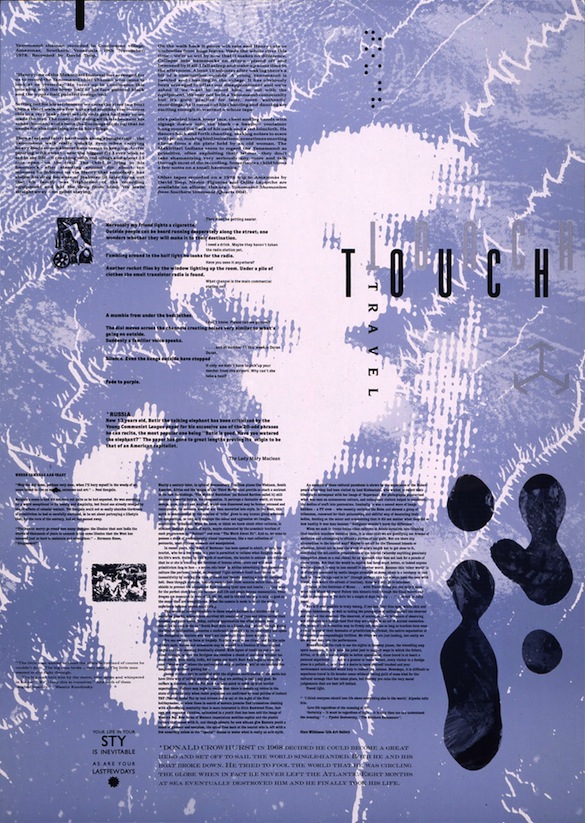
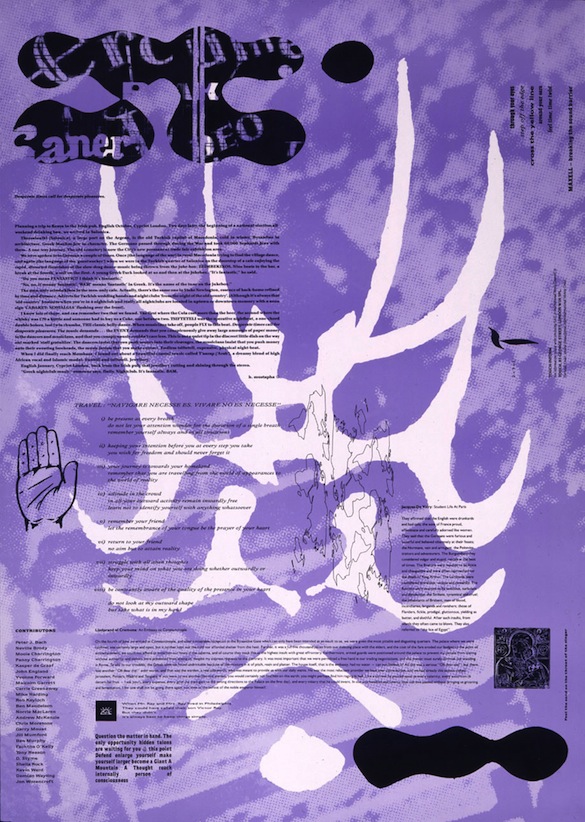
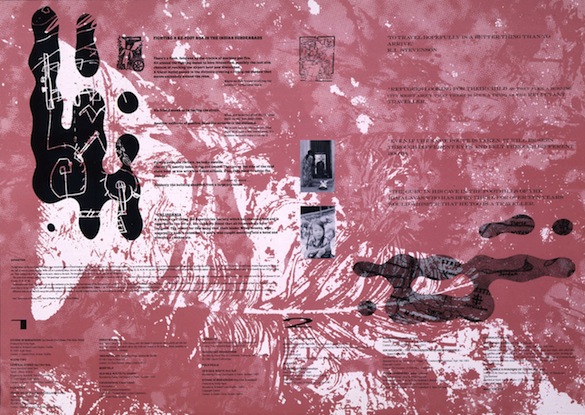
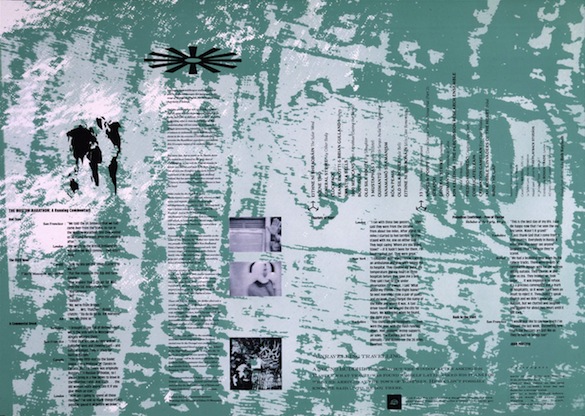
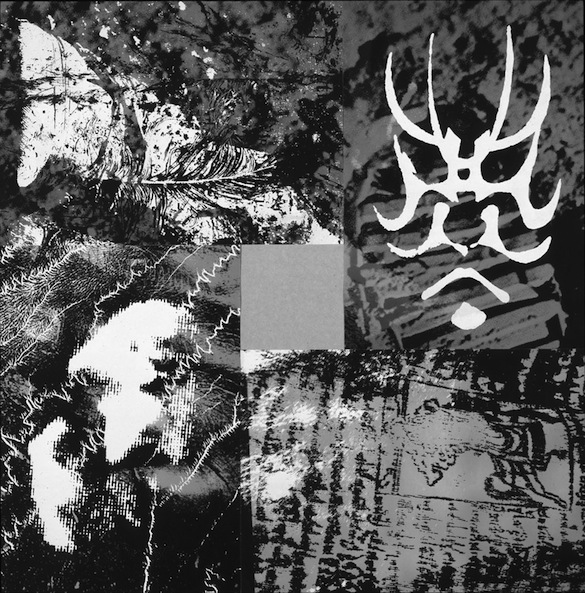
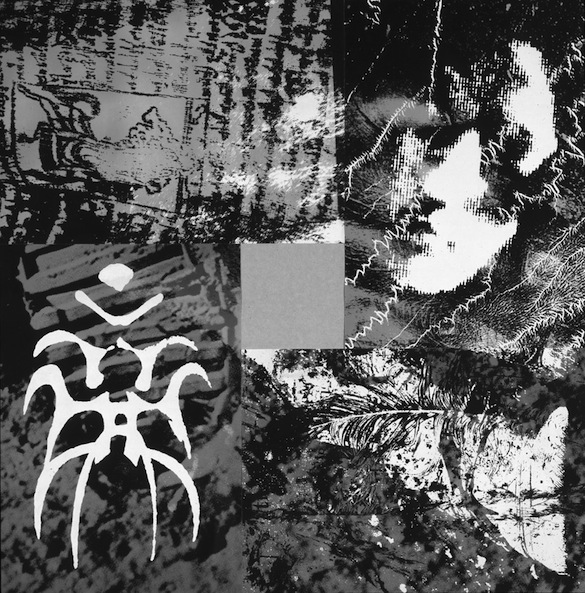
[images courtesy of Garry Mouat]
1986

Ritual: Magnetic North [T5]
x face
Within Living Memory
Regular Music – Purcell Manœuvres
Margaret Sambell – Metal Harmonics
S/Z – Call It Power
Gilbert And George – The World Of…
Biting Tongues – Feverhouse
Einstürzende Neubauten – Das Letzte Biest Am Himmel
Kent and Sayer – Memory Ground
The Nocturnal Emissions – Um Eh Eh Eh
Renaldo And The Loaf – Extracting the Re-Re
Kill Ugly Pop – One Minute Of Pure Venom
Strafe Für Rebellion – Rauperaha (Song Of The Maori Rebellion)
Fast Forward – Mamba
David Cunningham – Two Different Places
Touch 33 – North Star
y face
Autocue
The Residents – Theme For An American TV Show
Gilbert And George – Shadowed Valley
Camberwell Now – Daddy Needs A Throne
Wolfgang Wiggurs – Casting Of The Skin
Cabaret Voltaire – Diffusion
Gregorio Spini – Passing
Japanese For Monks
Last Few Days – Too Much Is Not Enough
Zazou And Bikaye – Signorina
Val Denham/tape treatments by A.M.McKenzie – I Touched The Memory
Gilbert And George – Another World Of…
Ricardo Mandolini – Canción De Madera Y Agua (Song Of Wood And Water)
Greater Than One – Urban Psychology
S/Z – Who Is The Author
Touch 33 – Greenhouse Effect
Silent Tongues – Sadhu Ritual Chant
Edited by Jon Wozencroft; Published by M Harding; Designed by Panni Charrington. Thanks to Rob Keyloch for editorial and production directions on mastering the cassette in April and November 1985.
Typesetting by The Printed Word, London. Printed by Sprinting. Colour reproduction by The Clifton Studio and Patina. Texts set in Albertus , Bodoni, Garamond, Futura, Zapf, Perpetua and Plantin.
A cassette-only version of the above was released in 1986 as:
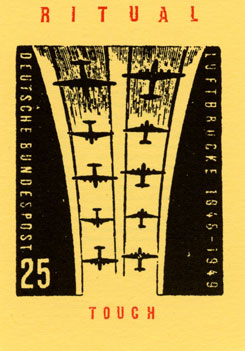
TOUCH: RITUAL [T5c]
The celebrity is a person tuned into an abstract. Their status has little to do with their achievement (or lack of it) but everything to do with their ability to fit in with the demands of the new mass media ritual. This involves availability, accessibility, pliability and respectability – ‘shocking’ people are carefully dropped in to add spice or to populate ghettos. As they parade across the surface of the electronic media, celebrities become symbols (and, occasionally, victims), members of the televisual elite encouraging emulation and aspiration – the modern call to prayer. [Jon Savage]
Audio content and notes: T5c = T5
Network21, a pirate TV station from London, broadcast this piece in 1986
Jon Wozencroft writes: “The episodes were compiled at the old London Film and Video Co-Op in Soho and then broadcast them from the top of a tower block at Worlds End in Chelsea…”
1983
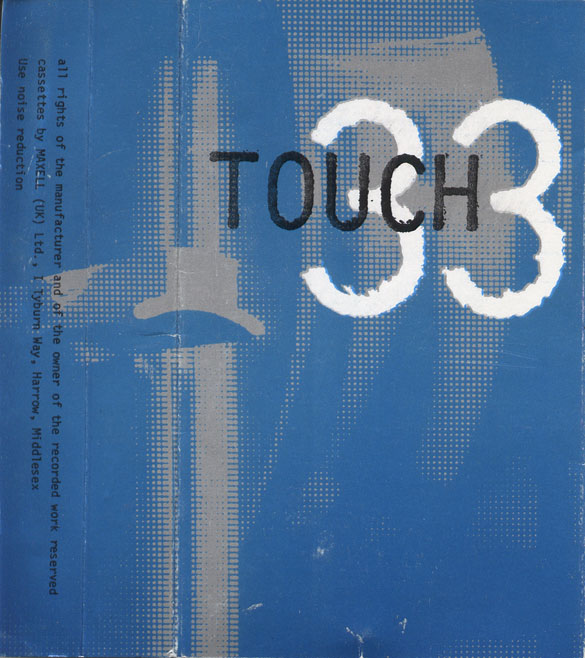
Touch 33 [T33]
Side One
The THIRD MIND
mobile
Koto Numariya : Nakano-xu
Andy Ross : Bush / Xylatymbou
1000 in the one
S. Eritrea : Chant
a clean mirror
Gamelan music from Bali
Soliman Gamil – Music Dialogue
return of paradise
Fasili Kassa : East of the river
Bamyali : Sheep
The Children’s Hour [read by Arthur Storey McKenzie]
Side Two
The LAST WAVE
Touch 33 / Andy Warhol : Orange Disaster
Flesh : Box [extract]
Terry Fox / Touch 33 : Internal Sound
Empty Words : Sign Language
NOT I : Triptych: i. The Blue Wind ii. 4 Doors iii. Painted Faces
Touch 33 ::: Lines in pursuit of the trinity achieved through a union of Eastern and Western consciousness within one medium
Edited by A.M.McKenzie and Jon Wozencroft. Design: Garry Mouat
Mastered at the suitcase studios 23/24 Jan 1983
1984
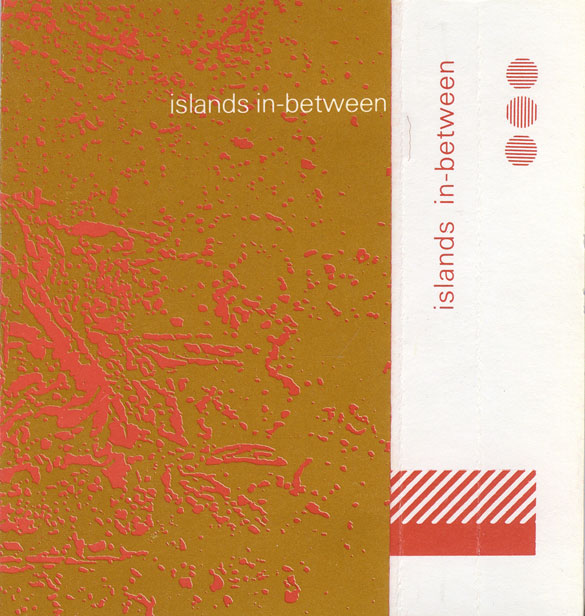
Islands In-Between [T33.2]
Side One
“Day and Night”
Gending Gending
Suling
Degung Instrumental
Genggong
Cremation Gamelan
Dag combination dance
King Rama
Ramayana ll
Side Two
“Watermark”
One Language
Temple Gamelan
Frog Sound
Degung instrumental no. 2
Ducks
Tenun
Anjung
Garuda
Indonesians often use the name ‘Nusantara’, meaning ‘the islands in-between’, when referring to the archipelago that forms their Republic. This cassette covers only some of the cultural activity on Java and Bali, the best known islands out of the 13,700 counted by statisticians, so it is not intended to be in any way definitive. The selections are more like musical postcards of two cultures balanced between tradition and tourism.
legend: meridian 105º – 115º east
Audio notes:
King Rama, One Language and Garuda were written and played by Jon Keliehor and Orlando Kimber. © Bruton Music
Side one
There is no specific translation for ‘Gending Gending’. The term generally means ‘orchestra’ or ‘gamelan composition’. The Javanese word for hammer is ‘gamel’, and the music is said to encourage the growth of plants. ‘Suling’ – the end blown flute. ‘Degung instrumental’ – from the Sudabese region of West Java to the speakers of tourists cafes. ‘Genggong’ – the first Balinese instrument, a mouth harp made from the palm and played by Igusti Ngurah Togog at his homestay in Peliatan, Bali. ‘Cremation Gamelan’ – a portable ensemble plays while the cremation tower is raised from the death pavilion. Before travelling a mile along the Peliatan road to the Temple of the Dead, the tower is spun around on its bearer’s shoulders to confuse the soul, preventing its return home to trouble the living. The overture played as the tower is set alight (with a magnifying glass – matches are thought to be unclean), is recorded on ‘Touch Travel’. Dag combination dance – in Bali, individual dances are sometimes merged into modern adaptations, not only as a result of tourism – the gamelan elders think popularisation is the best way to attract young people to dance, though dividing lines are difficult to draw. ‘Dag’ is a combination of ‘Kecak’ and ‘Kebyar’, performed from the squatting position in a pantomime style very popular with children. Attention is focused on the facial expressions of the dancers which interpret man’s ever-changing moods. ‘King Rama’ – the story of the ‘Kecak’ (monkey) dance is taken from the Hindu Ramayana epic and portrays Rama’a search for his wife, Sita, who has been abducted to the monkey forest. Rama is an incarnation of Vishnu, The Creator, and serves as an ideal for the Hindu man. ‘Ramayana ll’ – the opening sequence of the gamelan acvcompaniment to the 4 part ballet held on the full moon-lit nights of June, July and August at Prambanan temple complex. The largest central temple is dedictade to Shiva, the destroyer. The voices that follow were recorded on a train at Bandung station at 3am, en route to Yogjakarta. Local sellers board trains whatever the hour, and every carriage becomes an indoor market.
Side two
‘Watermark’ – nightfall by a bridge near the Monkey Forest, Ubud. ‘One Language’ – there are c. 300 different languages and dialects in Indonesia. After independence in 1945, Bahasa Indonesian became the universally accepted language, though its use had already been encouraged by Nationalists as a political tool against the Dutch colonisers, and sanctioned by Japanese invaders who wished to spread propaganda to the villagers. ‘Temple Gamelan’ – musicians play while women bring ornately prepared offerings to the temple shrines on auspicious days of the Hindu calendar. Spirits and demons cannot live without food and drink, so the women fan the essence towards the divine recipient before offerings are placed on the ground to waiting dogs. Smaller offerings made daily, are left at strategic points around the house and alongside the ricefields. ‘Frog Sound’ – the sound comes from the reed mouthpiece of the genggong harp. Played by Togog and his son. ‘Ducks’ – every morning young boys and old men direct the family ducks out of their pens and along narrow paths into ricefields that are wet enough to paddle in. ‘Tenun’ – the Balinese weaving dance depicting women working at this traditional craft. ‘Anjung’ – the name given to the hordes of semi-wild dogs that roam Bali’s villages, barking instinctively at any approaching white man. ‘Garuda’ – Indonesia’s national symbol is the Garuda bird. Vishnu’s chosen vehicle and thus the king of flight associated with creative energy. Garuda is a dominant motif in Indonesian art, the name of the national airline and the seal of the official state coat of arms, beneath which appears the words ‘Bhinneka Tunggal Ika’ – literally ‘many are there but there is only one’.
Mastered 22/23 April – use noise reduction. Edited by Jon Wozencroft and Mike Harding. Design: Jon Wozencroft
1985
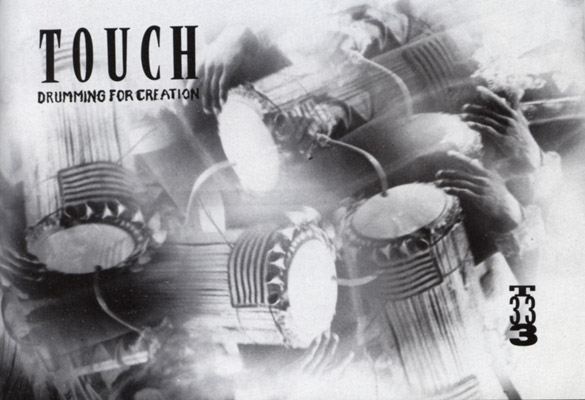
Drumming for Creation [T33.3]
Side a
Jaliya Musicians – ALLA L’AA KE
The Bagamoyo Group – 9 string ISEZE
Walo Shatan Gwari – FARMING IS THE MOST IMPORTANT OCCUPATION TODAY
Dundun – ARO/SEKERE
The Bagamoyo Group – DRUM CHIME
You can hear a lo res (ie second generation) stream of side a here
Side b
The Bagamoyo Group – 13 string ISEZE
Walo Shatan Gwari –
IF YOU HAVE SOMETHING TODAY, TRY AND ENJOY IT, FOR TOMORROW YOU MAY NOT BE ALIVE TO DO SO
Walo Shatan Gwari – LET US LOVE ONE ANOTHER
Dundun – DRUMMING FOR OBATALA
The Bagamoyo Group – DRUM & VOICE
Jaliya Musicians – KAIRA
You can hear a lo res (ie second generation) stream of side b here
Audio notes:
This tape and texts offers just a few examples from an event that encompassed drumming sessions and instrument making workshops, the West African pop of Sir Warrior and the London based Ochestra Jazira. Amongst the recordings available through specialist record shops is ‘Tanzania Yetu’, recorded by The Bagamoyo musicians in London for Triple Earth Records, and containing information that need not be duplicated here. Of the literature available, John Miller Chernoff’s ‘African Rhythm and African Sensibility’ is recommended (University of Chicago Press). The Gwari songtitles are literal translations as indicated in the Nigerian troupe’s programme notes. Thanks to the Arts Department of the Commonwealth Institute and the National Sound Archive for their time, support and resources. Tape encoded with Dolby B noise reduction. Cassette © Touch/Commonwealth Institute
Jaliya Musicians of the Gambia:
Mawdo Suso (voice & balaphon), Mamadu Suso (voice & kora), Mamanding Kouyateh (singer)
The Bagamoyo Group are from Tanzania
Walo Shatan Gwari: The ensemble, led by Malam Walo, belongs to the Gwari people of Niger State.
Drumming for Creation was edited by J.Wozencroft and M.Harding. Design by Panni and Mooie Charrington
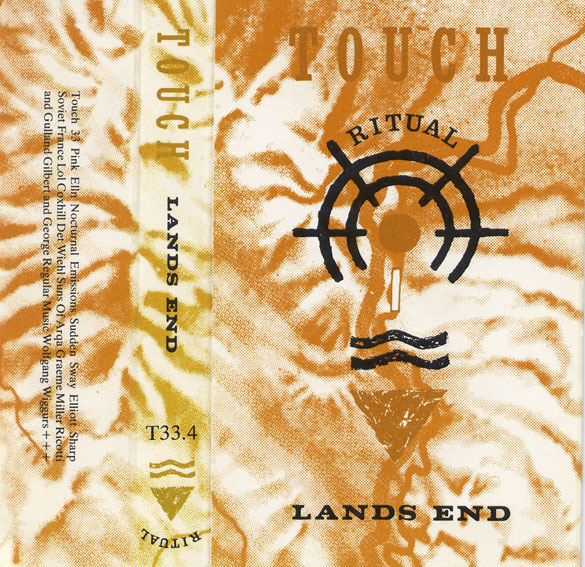
Ritual: Lands End [T33.4]
Side One
ritual +
Cross purpose
PINK ELLN – Lice Skitt Frög
Traffic Noise
Screaming Leaf
NOCTURNAL EMISSIONS – Metal Frames
A short jingle by SUDDEN SWAY
praise company
ELLIOTT SHARP – Black Rain
Ram
LOL COXHILL – 3/4
DET WIEHL – Play Sandwich
Side Two
Satsumaimo Man
SUNS OF ARQA – Sanskrit Hymn
GRAEME MILLER – Ash wei-ei-wah, Ash wei-ei-wah (Invocation of Past)
Snake Charmer
FRANK RICOTTI & BRIAN GULLAND – Pillow Under
GILBERT & GEORGE – Twisted and Aggressive
REGULAR MUSIC – Music For Film
WOLFGANG WIGGERS – Alluvium
Gregorio
1987
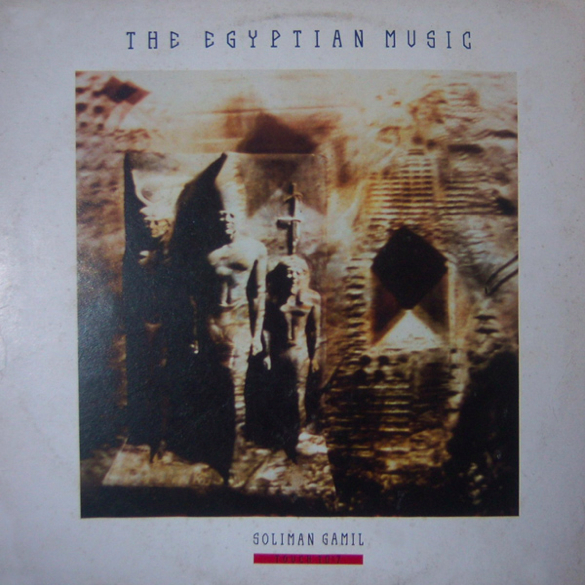
SOLIMAN GAMIL – The Egyptian Music [TO:7C]
Side One
Melody of Nile
The Sinsimia
Melody of Love
Inshad
Rhythmic Dialogue
Promenade on the Nile
Side Two
Sufi Dialogue
The Valley of Kings and Queens
Sacred Lake
Collecting the Harvest
Pretence and Destiny
The New Nubia
Audio notes:
Recorded in Cairo. Thanks to Suraya Moyine, The Egyptian State Information Service. Cover by P. & S. Charrington. This release was also issued on vinyl [TO:7LP] & CD [TO:7CD]
1988
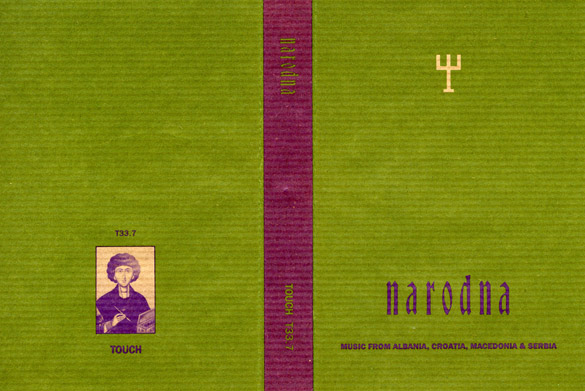
Narodna [T33.7]
Side One – Narodna (click to listen)
Pece Atanasovskog – Postupano Oro
The Musicians of Zagreb – Drmes (trad.)
Dragoslav Aksentijevic Pavle – Come All Ye Sons of the Earth
Pece Atanasovskog – Zetovsko Oro
Pece Atanasovskog – Berance
The Folk Orchestra of Albania – Vallje E Nuseve me Sharki
The Folk Orchestra of Albania – Dite E Zeze Ish Kone E Honja
Pece Atanasovskog – Staro Tikvesko Oro
Side Two – Narodna (click to listen)
Capella Ragusina – Himna Sv. Vlaha(trad.)
Dragoslav Aksentijevic Pavle – Polieleos Servikos
Dragoslav Aksentijevic Pavle – Kratima Terirem
Bells of Chilander
Himna Sv. Vlaha (instrumental)
Audio notes:
The Folk Orchestra of Albania was conducted by Qamili Vogel.
Narodna was mixed 11.11.88 by Tezak and de Galantha, with thanks to Dragoslav Aksentijevic Pavle and the Serbian Orthodox Church of Zagreb.
The cassette, which was packaged in a Magnam Products Microcase, contained a folded card [see above].
Design: Jon Wozencroft
1989
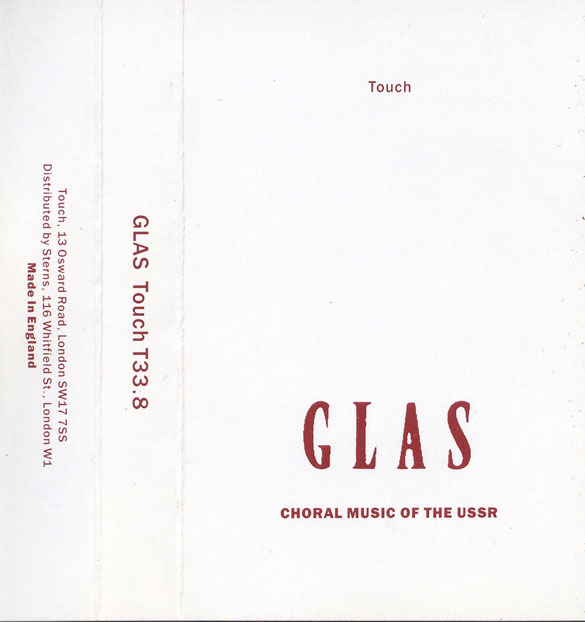
Glas c/w Ustá [T33.8]
Side One
Glas (click to listen)
Side Two
Usta (click to listen)
In 1932, a group from the remote town of Pik Grandisonyy, situated in the Vostochnyy Sayan near the Mongolian border, set out to escape the Great Famine and headed west. Having eaten their livestock, the villagers were forced to walk.; the journey would take two years. This collection represents some of the songs they sang on their way.
Design: Jon Wozencroft
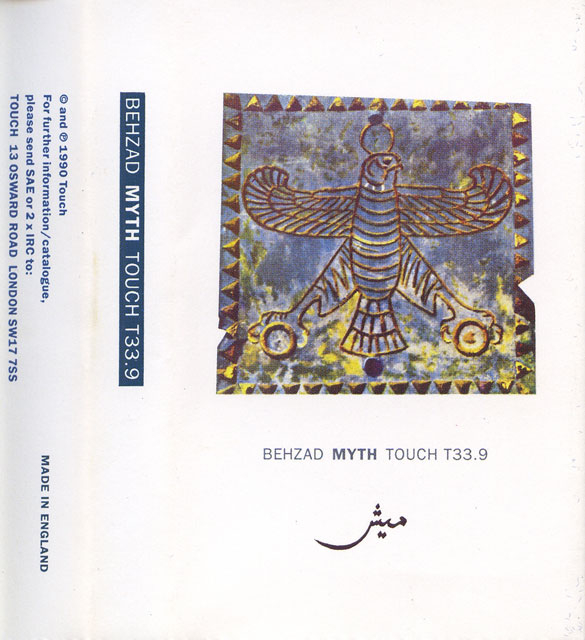
BEHZAD – Myth [T33.9]
Side One
Myth (Mish)
Love (Mitre)
Spring (Bahaar)
Friend (Doust)
Free (Azad)
Moving Sky (Nielofar)
Side Two
Change Bringer (Kavian)
Sun (Korsheed)
The End (Payan)
Apocalypse (Rastaxis)
Against Gravity (Afarin)
Mish
All arrangements of original songs are based on pre-Islamic music from the Sassanian and Achamenian eras (100 BC to 500 AD). Instruments used on this recording are: TAMBOUR – the first documentary evidence referring to this 3-stringed acoustic long-necked lute occurs in Susa, an ancient city in South West Persia. In ancient myth, Soroush (or ‘The Muses’) played the tambour to awaken humans with the sound of love as they slept after the creation of the world. Originally the lutes were called ‘star’ or ‘setar’, meaning ‘sound producer’. The sound of the tambour represents the planet Mars, or ‘the Iron Planet’. In Sufi music (ie post-islam), a tambour is usually played with the DAF – this tambourine represents the Sun and means ‘beat’ or ‘tap’ (the same root as the word ‘tabla’), which is the sound of the heart. Together, the tambour and the daf represent the planets revolving around the sun, and the combination of the rhythms symbolises the secret of creation. The daf also represents femininity and the tambour masculinity (as Yin and Yan). TOMBAK (featured here on Spring) is the most common drum to be found in Persian music. In the Sassanian era (the last dynasty before Islam), ‘tombak’ meant poetical rhythm, or the skilful use of the fingers to produce a wide range of sounds. It has the same linguistic derivation as ‘tambour’, and is made from wood and goat or sheep hide.
Inspiration for the songs comes from a desire to preserve pre-Islamic melodies and rhythms. More dynamic, they combine the immediacy of popular folk songs with an ancient classical spirit – the Iran that does not appear on television. In spite of ‘World Music’, Iranian pop is destroying Persian culture by ignoring traditional values and beliefs. Why should this be “inevitable”? A healthy tree has healthy roots.
Audio notes:
Recorded and engineered by Behzad Blourfroushan and Olivier Abitbol, to whom grateful thanks are due.
Kensington, Summer 1989
Design: Jon Wozencroft
Between 1984 and 1988, Touch released a series of cassettes which were packaged either as a standard cassette with extended inlay card, or with an A6 booklet in a clear plastic wallet. Here for the historical record are the front cover artwork, the audio & visual content, and notes. All are out of print, of course. The contents and credits are copied directly from the productions themselves.
1984
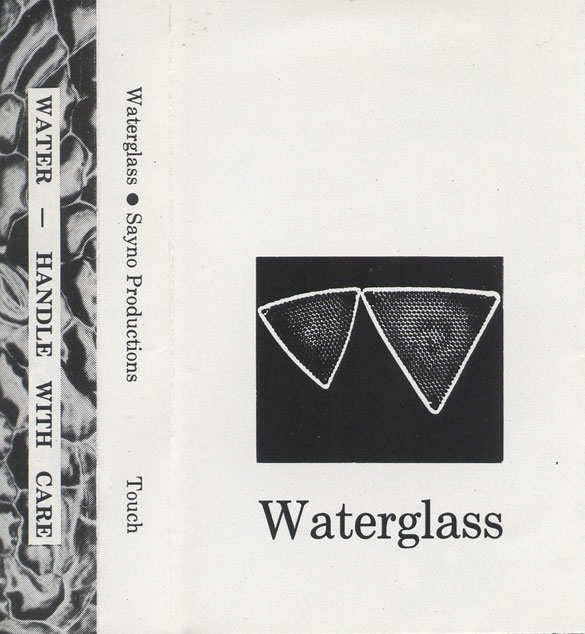
SAYNO PRODUCTIONS – Waterglass [TO:1]
[Each cassette inlay card also contained a colour photo from North Wales taken by Simon Tassano – a different one each time, from hundreds of gloss ‘snappy snaps’, cut in half at the printers]
Side One
Part 1
Side Two
Part 11
Audio notes:
Mixed at Elephant Studios 7-84. Tracks written by Sayer/Tassano. You can hear an extract here.
http://touch33.tnwa.touch33.net/wp-content/uploads/sites/27/waterglass.mp3Design: Jon Wozencroft
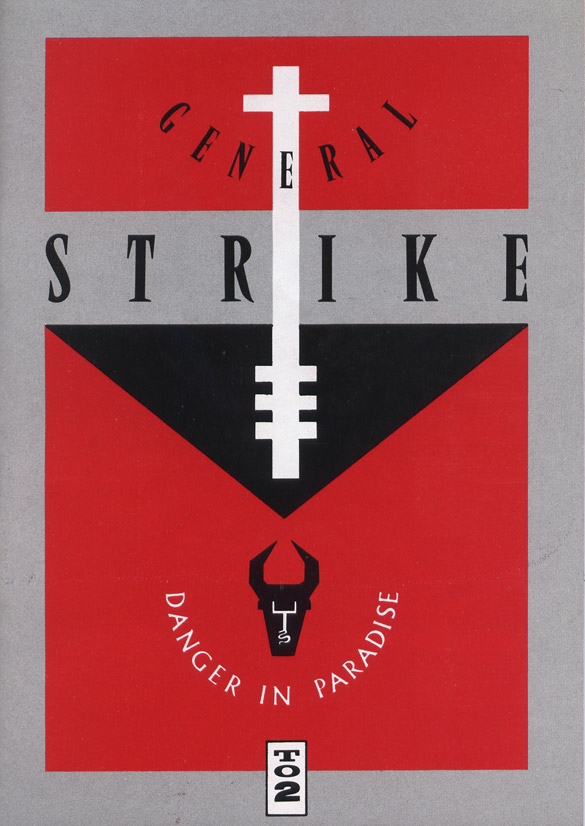
GENERAL STRIKE – Danger In Paradise [TO:2]
Side One
Interplanetary Music
The Fatal Glass
Next Day
Babycart to Hell
Snowdrops
The Barkless Dog
Guided Missiles
Side Two
My Other Body
Bamboo House of Dolls
Interplanetary Dub
We Travel the Spaceways
Friendless Animals
Sea Hunt
Danger In Paradise
Audio notes:
DAVID TOOP: guitar, prepared guitar, bass percussion, flute, alto flute, glockenspiel, vocals, tape noises, rhythm tracks. STEVE BERESFORD: bass, piano, glockenspiel, Farfisa organ, trumpet, Prophet, flugelhorn, toy piano, euphonium, percussion, vocals, melodica, noises, rhythm tracks
with guests: Lol Coxhill, tenor saxophone on guided missiles and soprano saxophone on interplanetary music + dub. Dawn Roberts, vocal on my other body. Maartje Ten hoorn, violin on interplanetary music.
Composed in Brixton, Stoke Newington, Clapham, Venezuela by Toop & Beresford except: interplanetary music, we travel the spaceways – SUN RA – Dub Sun Ra Toop Beresford Cunningham & guided missiles – THE CUFF LINKS. Thanks to Yoshiaki Kinno, Dave Ramsden, Whirled Music, Lloyd Bridges.
Photographs a-i taken by Martin Proctor in Cairo & Giza; Cadiz, Valencia, Jerez & roundabout; Janta Manta, Jaipur; The Wailing Wall, Jerusalem. Package arranged by Jon Wozencroft & designed by Panni Charrington. Thanks to Richard Cook.
The package contained a postcard [see above]
1986
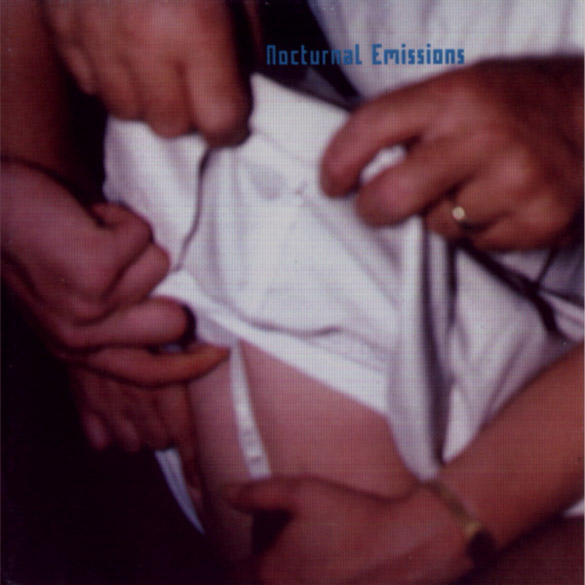
THE NOCTURNAL EMISSIONS – drowning in a sea of bliss [TO:4]
Anthems of the Meat Generation
Photography by Panni Charrington. Inlay card photo: Nigel Ayers
The cassette, which was packaged in a Magnam Products Microcase, contained a folded card [see above]
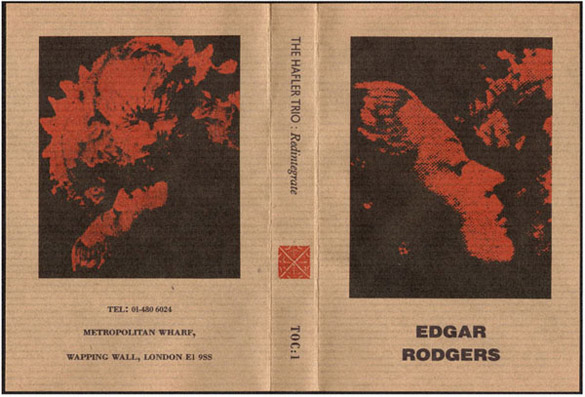
THE HAFLER TRIO- Redintegrate [TOC:1]
NO IS FOR NOISE REDUCTION
Since 1953, The Hafler Trio has continued to implement the disuputed findings of the acoustic researcher Robert Spridgeon. ‘Redintegrate’ is a compendium of details taken from recordings made since that time, many of which are included more extensively than on [the above releases]. Each bears out Spridgeon’s deposition: ‘Until man can learn to set himself from himself, what he is from what he does, there can be no real hope of creation’.
Redintegrate was sponsored by EDGAR RODGERS and The Bureaux Clothing Group, established in 1982. The cassette, which was packaged in a Magnam Products Microcase, contained a folded card [see above] and, separately, with 3 postcards by Panni Charrington. Design: Jon Wozencroft
1. Symbolising Kundalini
2. Symbolising Tantra
3. Symbolising the Elements
1988
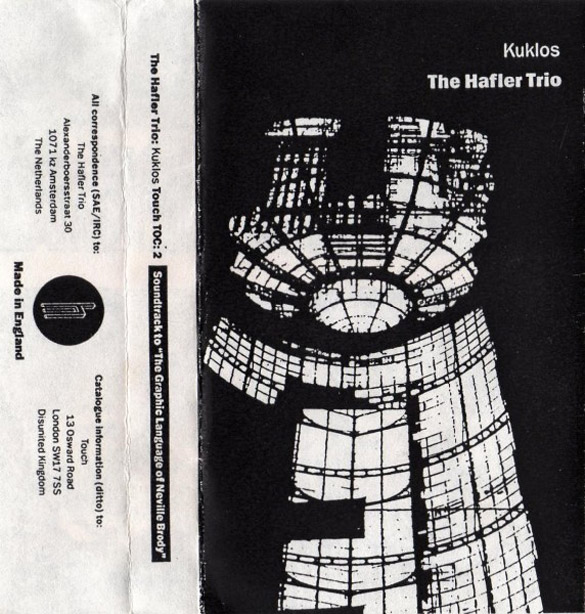
THE HAFLER TRIO – Kuklos [TOC:2]
Intention, attention and duplication
Soundtrack to “The Graphic Language of Neville Brody”
Design: Jon Wozencroft










